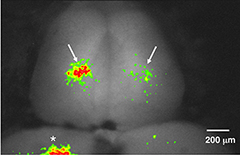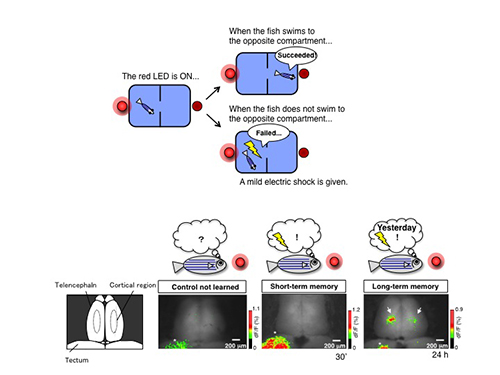May 17, 2013 Press Release Biology
Fishing for memories
In our interaction with our environment we constantly refer to past experiences stored as memories to guide behavioral decisions. But how memories are formed, stored and then retrieved to assist decision-making remains a mystery. By observing whole-brain activity in live zebrafish, researchers from the RIKEN Brain Science Institute have visualized for the first time how information stored as long-term memory in the cerebral cortex is processed to guide behavioral choices.

The study, published today in the journal Neuron, was carried out by Dr. Tazu Aoki and Dr. Hitoshi Okamoto from the Laboratory for Developmental Gene Regulation, a pioneer in the study of how the brain controls behavior in zebrafish.
The mammalian brain is too large to observe the whole neural circuit in action. But using a technique called calcium imaging, Aoki et al. were able to visualize for the first time the activity of the whole zebrafish brain during memory retrieval.
Calcium imaging takes advantage of the fact that calcium ions enter neurons upon neural activation. By introducing a calcium sensitive fluorescent substance in the neural tissue, it becomes possible to trace the calcium influx in neurons and thus visualize neural activity.
The researchers trained transgenic zebrafish expressing a calcium sensitive protein to avoid a mild electric shock using a red LED as cue. By observing the zebrafish brain activity upon presentation of the red LED they were able to visualize the process of remembering the learned avoidance behavior.
They observe spot-like neural activity in the dorsal part of the fish telencephalon, which corresponds to the human cortex, upon presentation of the red LED 24 hours after the training session. No activity is observed when the cue is presented 30 minutes after training.
In another experiment, Aoki et al. show that if this region of the brain is removed, the fish are able to learn the avoidance behavior, remember it short-term, but cannot form any long-term memory of it.
“This indicates that short-term and long-term memories are formed and stored in different parts of the brain. We think that short-term memories must be transferred to the cortical region to be consolidated into long-term memories,” explains Dr. Aoki.
The team then tested whether memories for the best behavioral choices can be modified by new learning. The fish were trained to learn two opposite avoidance behaviors, each associated with a different LED color, blue or red, as a cue. They find that presentation of the different cues leads to the activation of different groups of neurons in the telencephalon, which indicates that different behavioral programs are stored and retrieved by different populations of neurons.
“Using calcium imaging on zebrafish, we were able to visualize an on-going process of memory consolidation for the first time. This approach opens new avenues for research into memory using zebrafish as model organism,” concludes Dr. Okamoto.
Reference
- Tazu Aoki, Masae Kinoshita, Ryo Aoki, Masakazu Agetsuma, Hidenori Aizawa, Masako Yamazaki, Mikako Takahoko, Ryunosuke Amo, Akiko Arata, Shin-ichi Higashijima, Takashi Tsuboi and Hitoshi Okamoto. “Imaging of Neural Ensembles for the Retrieval of Learned Behavioral Programs.”Neuron, 2013, doi: 10.1016/j.neuron.2013.04.009
Contact
Hitoshi Okamoto
Laboratory for Developmental Gene Regulation
RIKEN Brain Science Institute
Jens Wilkinson
RIKEN Global Relations and Research Coordination Office
Tel: +81-(0)48-462-1225 / Fax: +81-(0)48-463-3687
Email: pr@riken.jp

Neural activity is observed in the dorsal part of the fish telencephalon when LED is presented, 24 hours after training
